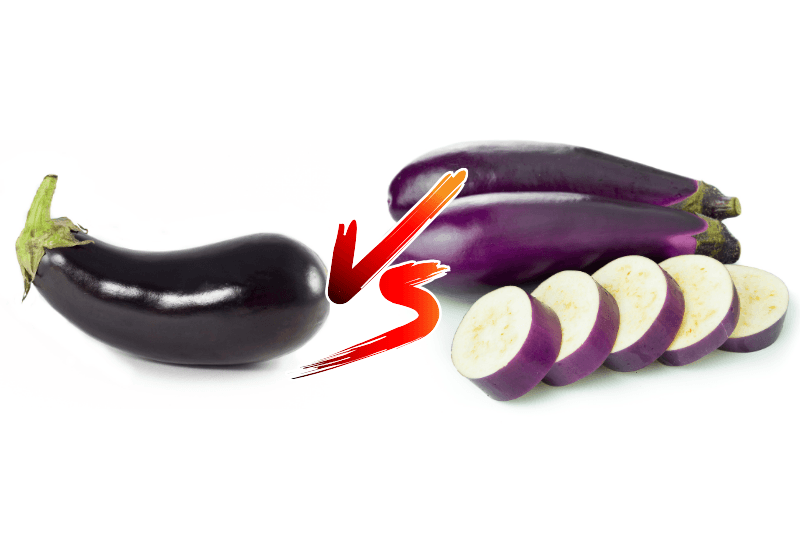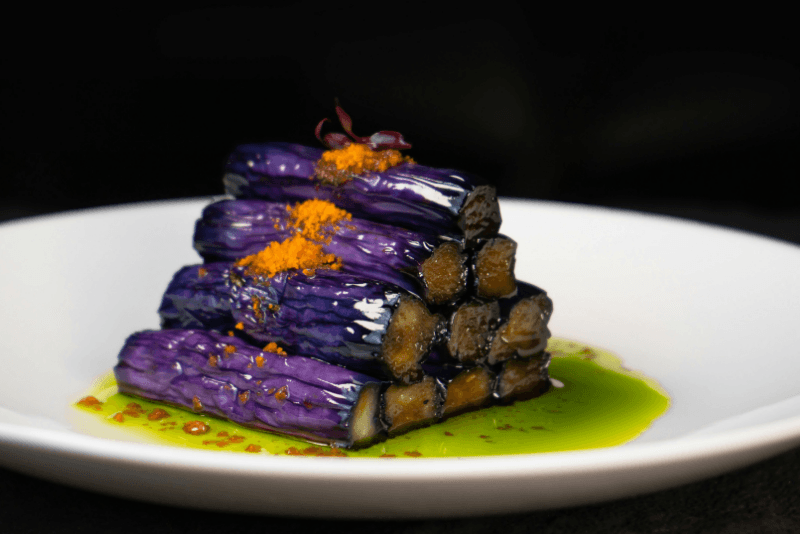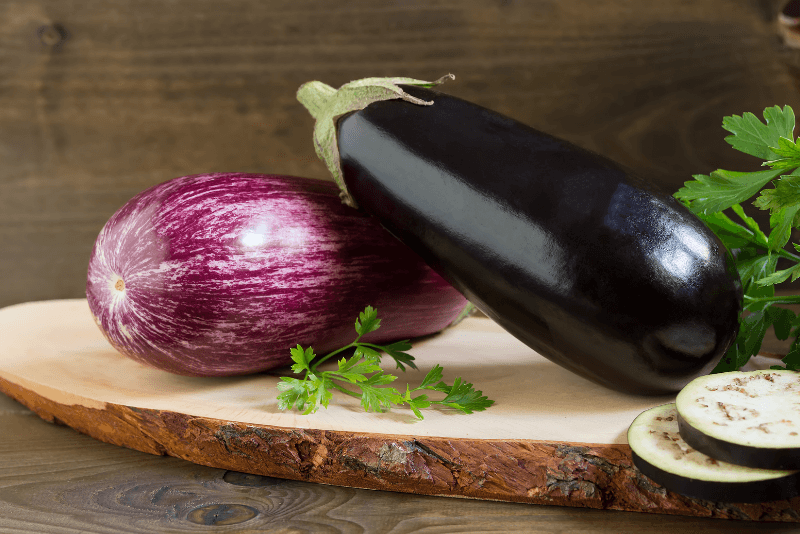Certain things just don't belong in miso soup. Ketchup. Cinnamon. And big, chewy chunks of eggplant - No Thank You!
But wait, isn't eggplant a traditional ingredient in Miso Soup? Don't you sell eggplant and ginger miso soup on your site?
Yes, it is, & yes we do.
But here's the inside scoop: not all eggplant is created equal. If you've ever tried making miso soup with the typical North American eggplant, you've likely discovered that it's not all it's cracked up to be.
So what's the secret to those silky, tender chunks of flavorful eggplant that take a simple bowl of miso to the next level?
Read on to find out.
Looking for a convenient, healthy instant miso soup?
The Problem with the "Usual" Eggplant
Let's be fair to the classic globe eggplant sold throughout North America. It has its strengths. It's hearty, meaty, and holds up beautifully in oven-baked dishes. Think dripping cheese and tomato sauce.
But miso soup is not lasagna. It's subtle, brothy, and umami-forward—every ingredient matters.
What happens when you toss a chunk of globe eggplant into your miso:
- Too firm or too mushy: It can be challenging to find that perfect balance. Often it's undercooked and spongy or overcooked and falling apart.
- Overpowering flavor: Globe eggplant carries a bitterness that can dominate delicate broths.
- Grease trap: It soaks up oil like a sponge, which can weigh down a dish meant to be light and comforting.
- Visual blah: Once cooked, it tends to lose its appeal — turning into a dull, grayish blob.
Instead of melting into miso harmony, globe eggplant feels like it got lost on its way to a backyard grill.
Meet Nasu: Japan's Eggplant Hero

Japanese eggplant, or nasu (なす), isn't just a "smaller eggplant." It's a variety that was developed in parallel with Japanese cuisine. It's long, slender, and elegant, with deep purple skin and a texture that was practically made for simmered dishes.

In Japan, nasu is featured in everything from agedashi nasu (deep-fried eggplant in broth) to nasu dengaku (miso-glazed eggplant). But it really shines in miso soup.
What Makes Nasu So Special?
- Tender Texture: Cooked nasu becomes silky and smooth, blending seamlessly into broths.
- Sweet, Mild Flavor: There's no bitterness to mask. It naturally enhances miso's umami.
- Thin, Edible Skin: No peeling needed, and it holds its shape without toughening.
- Flavor Sponge: It absorbs miso and dashi like a pro, turning every bite into a flavor bomb.
- Visual Appeal: The deep purple pieces add color and elegance to a light broth.
Nasu doesn't just "work" in miso soup. It makes the soup better.
Umami Synergy: How Nasu Transforms the Broth
When you simmer nasu in miso soup, something beautiful happens. It doesn't just soak up flavor — it gives back.
Scientifically speaking, nasu releases amino acids (including glutamate) into the broth. These natural compounds elevate the umami level of the soup, making it rounder, deeper, and more satisfying.
It's the same reason chefs add mushrooms, kombu, or bonito flakes to broth: umami synergy. Nasu joins that party effortlessly.
Flavor Harmony in Action
- Balances the saltiness of miso with natural sweetness
- Deepens the broth with glutamate and subtle earthy notes
- Creates texture contrast with tofu and seaweed
In every way, nasu helps miso soup achieve what it's meant to be: a perfectly balanced bowl of comfort.
Why We Chose Nasu for Our Instant Miso Soup
When we created our freeze-dried miso soup, we weren't trying to replicate the miso soups you find in plastic takeout containers. We wanted to capture the taste of authentic miso soup — the kind served in Japanese homes and ryokan inns. The kind that makes you pause after the first sip.
That meant being intentional with ingredients.
Could we have used the more widely available globe eggplant? Sure. But then it wouldn't have been real miso soup. It would've been a soup with miso in it. There's a difference.
Our Guiding Principle: Authenticity First
We chose nasu because it's the eggplant that's actually used in Japan. Not to be trendy. Not to be artisanal. But because it's the right ingredient for the job.
In Japan, nasu in miso soup isn't an upgrade. It's the default. And for good reason:
- It cooks quickly, making it perfect for fast meals
- It brings visual and textural elegance
- It tastes like it belongs
We don't add ingredients to fill space. Every component in our soup is there for a reason. With nasu, that reason is authenticity, flavor, and respect for the dish.
The Bigger Picture: It's About More Than Eggplant
We're not saying globe eggplant is bad. It's just not right here. This decision — to use nasu — is part of a larger philosophy:
- Use ingredients with purpose
- Stay close to the culinary roots of the dish
- Respect your taste buds
Food should be simple, delicious, and true to its origin. That's why we used nasu. And it's why you'll taste the difference.
Taste the Nasu Difference

We could go on about amino acids, umami synergy, and textural integrity. But honestly? The best way to understand Nasu's magic is to taste it.
Once you try our miso soup made with real Japanese eggplant, you won't want to go back to anything else. It's not just soup. It's a perfectly balanced bowl of comfort, tradition, and harmony.
Ready to taste the real thing? Try our authentic miso soup with Japanese nasu.
About Tsubi Soup
Founded by Tsubasa "Tsubi" Nishitani, our soups are crafted with love, using clean, plant-based ingredients and delicious veggies for a taste that’s both comforting and wholesome.
FAQ
Is Japanese eggplant the same as Chinese eggplant?
They're similar in shape and both are milder than globe eggplants, but Japanese eggplant (nasu) tends to be slightly thinner and sweeter, with a more delicate skin. For miso soup, nasu is preferred for its flavor absorption and softer bite.
Can I find nasu in American grocery stores?
Some well-stocked grocery stores and most Asian markets will carry nasu. It's usually labeled as Japanese eggplant and looks long, thin, and dark purple.
Is nasu healthier than regular eggplant?
Both types are nutritious, but nasu tends to absorb less oil when cooked and is lower in bitterness, which can make it a lighter and more pleasant option in soups and stir-fries.
Can I use globe eggplant in miso soup if I can't find nasu?
You can, but you'll need to prep it carefully: salt it to reduce bitterness, peel it to avoid tough skin, and cook it longer. Even then, the texture and flavor won't quite match nasu.
Why does nasu taste better in miso soup?
It's all about synergy. Nasu blends seamlessly into miso broth — enhancing the umami, soaking in flavor, and providing a melt-in-your-mouth texture that makes every bite more comforting.
Is the eggplant in your miso soup fresh or preserved?
We use real Japanese nasu that's been gently freeze-dried to lock in flavor and texture — no additives, no shortcuts. It rehydrates beautifully into soft, savory bites.

